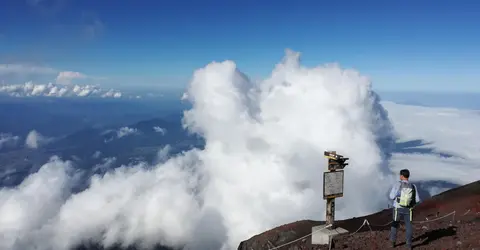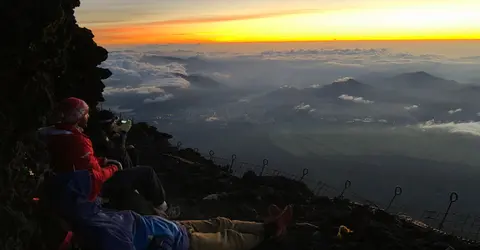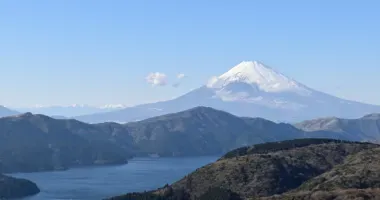Mount Fuji Climbing Routes
The four paths
Before organizing your excursion to the top of the sacred mountain, be sure to have all the cards in hand to choose the route that meets your expectations. Each trail has its specificities and will offer you a unique experience.

Our special envoy in full contemplation
ABA
Many factors are taken into account when choosing the route to reach the summit at 3,776 meters above sea level : the ease of access to the starting point, the approximate walking time for the ascent and descent, the view you will have during the ascent as well as the drop. Some trails are more developed than others, with well-defined paths and a greater number of refuges and supply points at the various stations. Here are the four trails and their characteristics .
Yoshida
The Yoshida trail on the northern side of the mountain is the most popular by far, since 60% of people who attempt the ascent prefer it to the other trails ( 172,000 people in 2017). This is due to the fact that it is the most accessible from Tokyo and has been developed over the years to accommodate the crowds. The 5th station, the starting point for most climbers, actually marks half of the Yoshida Trail, since it starts at the very bottom of the mountain at Fuji Sengen Shrine. Tourists do not go there only during the ascent, but throughout the year to admire the view of the region of the 5 lakes . It is this path that the Japan Experience team took in early July 2018 for their ascent.
To read: Report, the ascent of Mount Fuji
Useful information :
- elevation: 2,300m
- ascent: 6h - descent: 4h
- different ascent and descent routes - joins the Subashiri trail between the 8th station and the summit
- winding but fairly flat path until the 7th station, then more rocky
- many shelters at the different stations on the way to the ascent, public toilets, shops and information point
- access: bus from Kawaguchiko and Fujisan stations
- first aid center at the 5th, 7th and 8th stations
Subashiri
The 5th station of the Subashiri trail is quite accessible since it is served several times a day by shuttles during the ascent. However, it offers only a few catering points to visitors, it is essentially a car park which is only used as a bus depot. From the station, you can reach a small peak in a 20-minute walk named Kofuji (literally "little Fuji"), which rises to 1,979 meters above sea level. The trail to the top of the sacred mountain crosses the forest and is only lightly used (23,500 people in 2017), until the 8th station where it joins the Yoshida trail and its thousands of apprentice mountaineers.
Useful information :
- altitude: 2000m
- ascent: 6h - descent: 3h
- different up and down routes - joins the Yoshida trail between the 8th station and the summit
- fairly gentle and wooded slope up to the 7th station
- refuges from the 8th station only
- access: bus from Gotemba and Shinmatsuda stations
- no first aid center
Gotemba
It is the least used of the four trails (18,000 people in 2017) and therefore the one with the least infrastructure . The starting point is only 1,400 meters above sea level, which is much lower than other trails . It therefore takes longer to reach the summit, on a path mostly covered with old lava flows without vegetation. However, this becomes an advantage during the descent, since you can almost run on the smooth terrain of the trail, and the sunrise is visible regardless of your altitude.
Useful information :
- elevation: 1,400m
- ascent: 7h - descent: 3h
- different ascent and descent paths halfway through
- gentle slope of volcanic gravel to the 8th station
- some refuges from the 7th station, shops, information point and public toilets
- access: bus from Gotemba station
- no first aid center
Fujinomiya
The last trail is the second most used ( 70,000 people in 2017), and also the most accessible for people in the west of the country (Kyoto, Hiroshima). Its 5 th station is the highest on the mountain and you will find a shop there to buy the equipment necessary for the ascent. Two negative points: the path is the same to go up and down, and the sunrise is only visible at the top.
Useful information :
- elevation: 2,400m
- ascent: 5h - descent: 3h
- identical ascent and descent paths
- rough, rocky and steep terrain
- huts at all stations
- access: bus from Mishima, Fuji, Shin-Fuji and Fujinomiya stations
- no first aid center

In place to watch the show
TMA
Bonus: Ochudo
If you are not in Japan during Mount Fuji climbing season and the mountain is not too snowy, or if you do not think you have the physical abilities to reach the summit, the small Ochudo trail is for you. for you ! Instead of going up, it crosses the side of the mountain horizontally . Formerly, it was a 20 kilometer pilgrimage that only those who had already climbed at least 3 times had the right to perform. Today, most of the route is closed because it is not secure, but you can enjoy 5 kilometers of the trail accessible from the 5th station of the Yoshida trail (also called Fuji Subaru Line).
For further :
Address, timetable & access
Address
Access
Yoshida: July 1 to September 10 Other trails: July 10 to September 10Website
http://www.fujisan-climb.jp/en/trails/index.html


























